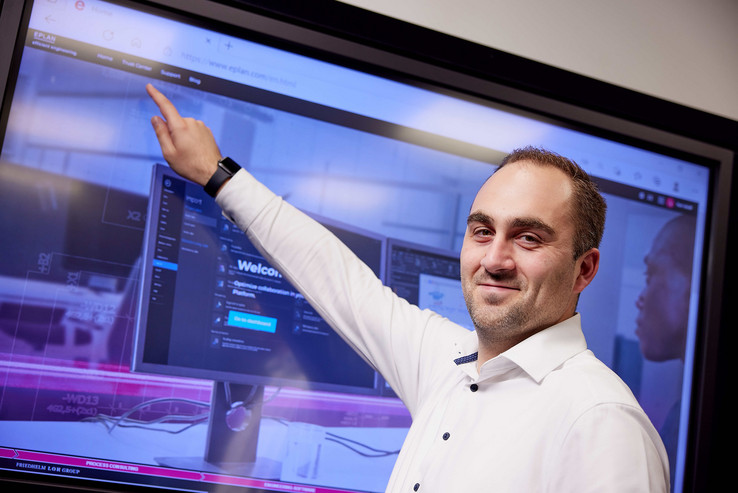EPLAN Engineering Standard
The standard gives you wings
Every electrical engineering project requires a project template. Design engineers mostly develop this themselves, which can be a time-consuming and error-prone process. Wouldn’t it be better to use predefined standards? Yes, says Tom Wolff, Head of EPLAN Engineering Standard, in an interview with the German trade magazine “Konstruktionspraxis”. The ultimate aim is to be able to select and download a project and then simply get started!
Mechanical and plant engineering projects are becoming increasingly complex, and the range of software functions is also steadily growing. Do users have any hope of keeping up?
Wolff: The fast-moving nature of the electrical engineering sector makes this a real challenge. New trends, issues and products keep on creating new requirements. For one thing, software always needs to offer a state-of-the-art solution and the best possible support for electrical design engineering. For another, article data – in the EPLAN Data Portal, for instance – has to be available for the engineering system and include all relevant information. The concept of training still plays a key role, too. The benefits of consulting and training simply can’t be underestimated when it comes to mastering these tasks as effectively as possible.
How does EPLAN support users?
Wolff:We support our users in a number of ways. For example, we always keep our software up to date for subscription customers. A new version of the EPLAN Platform is released every year, with features and functions that support the latest trends and workflows. The standardised article data in our EPLAN Data Portal also helps design engineers – so we offer the perfect combination of software, engineering data and services such as consulting.
What actually is the EPLAN Engineering Standard?
Wolff: The EPLAN Engineering Standard combines all our practical know-how and provides data in the form of standardisation templates, application examples, best practices and industry examples for users to download. In this way, we are looking to help them get started as quickly as possible, with the maximum value creation. In conjunction with the EPLAN Data Standard, which has been around for a few years now, we thus create added value for users.
What are the benefits for customers?
Wolff:Our aim is to provide added value for our customers, while also acting as an enabler and partner. To do so, we supply them with ready-to-use examples and initial, simple standardisations in template format – with predefined solutions for getting started quickly. We also exchange knowledge directly with our customers, something that I personally am a big fan of. We are delighted about the level of commitment being shown by our customers and hugely appreciate this type of collaboration.

Easy and faster implementation – the EPLAN Engineer¬ing Standard offers proven templates, examples and best practices.
Where can EPLAN users find the relevant information?
Wolff:At the moment, users will find it in our EPLAN Cloud, on our eplan.com website, but we are planning to gradually make access easier. The EPLAN Platform 2024 user interface already has a button taking users to where they can download the data. Looking ahead, we want to increasingly merge everything so that example data is available to users directly from their engineering environment. They will also find standardisation templates, because every new project starts off with a project template. You could say we provide a basic project based on the relevant technical standards and the typical EPLAN settings. Around 80 percent of the standards are thus already predefined. The highest configuration level also contains complete industry examples that reflect typical tasks from a variety of sectors.
What industry examples are currently available, and where does the data for them come from?
Wolff: There is currently an example from the building automation sector relating to heating, ventilation and climate control. It provides a fully engineered project with typical VDI-compliant preliminary planning. Schematics generated using EPLAN Electric P8 are also integrated, including the digital twin of a 3D enclosure in EPLAN Pro Panel. And at this year’s SPS trade fair, we are intending to launch an industry example relating to energy.Absolutely all the data comes from practical experience – nothing has been invented, as it were. The impetus for projects of this kind is the result of close contact with experts from the relevant sectors, who are also actively involved. What we envisage is that the project could, in theory, be rolled out immediately – in other words, simply make a start, order articles, hand over to the Rittal Application Center and have the enclosure, for example, manufactured.
New customers will definitely benefit most from this service, won’t they?
Wolff: Absolutely – new users will benefit because they will be able to work productively with the software in no time at all. However, even existing customers who have experienced all the various versions of EPLAN with us will benefit. Even if they have potentially worked hard to develop their own standardisation templates, they will often still find a good tip in these examples.
Creating added value
Application examples for specific insights into how typical tasks can be implemented in EPLAN Practical templates for basic or macro projects as an initial basis for working in a standardised way Access to typical project examples that are frequently used in a variety of sectors Best practices as suggestions for the systematic implementation of specific software functions



